| Columns Retired Columns & Blogs |
There are only 8 ohms in both modes and bridged. But have you measured it on 4 ohms too?
I used my Audio Precision SYS2722 system for the testing. I performed complete sets of measurements on one of the Plinius A-150s that had been auditioned by JVS (serial number 8797) in both class-AB and class-A stereo modes. I then repeated the testing with the A-150 in bridged-mono mode. I preconditioned the A-150 in class-AB mode by following the CEA's recommendation of running it at one-eighth the specified power into 8 ohms for 30 minutes. At the end of that time, the temperature of the top panel was 90.7°F (32.6°C) and that of the side-mounted heatsinks 90.1°F (32.3°C).
After I finished the class-AB testing, I switched the amplifier into class-A and left it idling for 20 minutes. (An amplifier with a class-A output stage runs hottest when idling.) Although the manual says that the amplifier will become "quite hot" in class-A mode and 20 minutes is less than the time after which the amplifier automatically switches into class-AB, the temperature of the massive heatsinks was 113.8°F (45.4°C). The top-panel grilles were hotter, at 121.4°F (49.7°C). In an email, US Plinius representative Ralph Abramo told me that the class-A bias current is set for the first 30% of the specified output power of 150W into 8 ohms, ie, 50W. He confirmed that the standing DC bias current for each of the complementary output stages in class-A is the appropriate 1.4A.
The Plinius's balanced and single-ended inputs preserved absolute polarity, ie, were noninverting, in both stereo and mono modes. The A-150's input impedance is specified as 47k ohms. I measured 59k ohms at all audio frequencies for the balanced input. The single-ended input impedance was 50k ohms at 20Hz, 45k ohms at 1kHz, and 36k ohms at 20kHz. The voltage gain at 1kHz into 8 ohms in stereo mode is specified as 32dB for the single-ended input and 38dB for the balanced input. However, I measured 31.3dB for both input types. For the bridged-mono mode, I followed the instructions in the manual to use the right balanced or single-ended input and to connect the positive speaker lead to the right channel's positive terminal, the negative speaker lead to the left channel's positive terminal. With these connections, the mono amplifier's gain into 8 ohms was the expected 6dB higher than in stereo mode.


The output impedance in bridged-mono mode, including the series impedance of 6' of spaced-pair cable, was a low 0.12 ohms at low and middle frequencies and 0.16 ohms at the top of the audioband. The output impedance in stereo mode was similar, at 0.135 ohms at 20Hz and 1kHz, rising to 0.16 ohms at 20kHz. As a result, the variation in the frequency response with our standard simulated loudspeaker (fig.1, gray trace) was ±0.2dB. The response into resistive loads (blue, red, cyan, magenta, and green traces) was flat up to 10kHz, and then was down by 0.25dB at 20kHz and 3dB at 56kHz. The mono frequency response was identical. In both modes, there was no overshoot or ringing in the Plinius's reproduction of a 10kHz squarewave into 8 ohms (fig.2).

In stereo mode, the channel separation, ref. 20V into 8 ohms, was 80dB in both directions across the audioband. With the chassis grounded via the rear-panel switch, the unweighted, wideband signal/noise ratio (ref. 1W into 8 ohms), taken with the single-ended input shorted to ground, was an excellent 79dB in both channels. This ratio improved to 84.2dB when the measurement bandwidth was restricted to 22Hz–22kHz, and to 86.8dB when A-weighted. These S/N ratios were 3dB lower in bridged-mono mode. Spectral analysis of the low-frequency noisefloor while the Plinius drove a 1kHz tone at 1Wpc into 8 ohms revealed a low random noisefloor, and while even-order harmonics of 60Hz were present, these all lay at or below –100dB in both stereo (fig.3) and mono modes. Lifting the chassis ground with the switch introduced higher levels of 60Hz and its odd-order harmonics. I performed all the testing with the amplifier's chassis grounded.

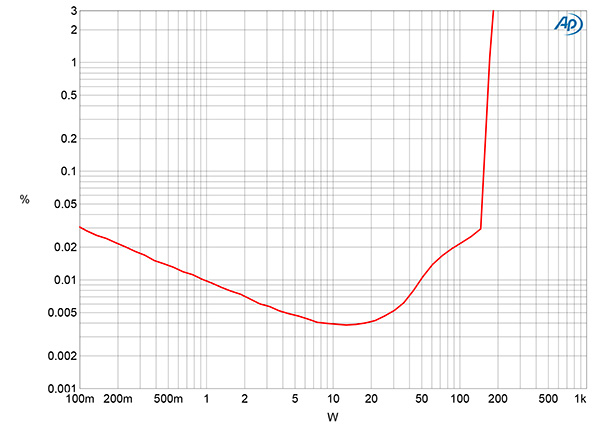
Plinius specifies the A-150's maximum continuous power as 150W into 8 ohms (21.76dBW) and 250W into 4 ohms (21dBW). With the clipping power defined as when the THD+noise reaches 1%, with both channels driven, in class-AB the A-150 clipped at 170W into 8 ohms (22.3dBW, fig.4) and 260W into 4 ohms (21.14dBW). The maximum power was the same in class-A, but the THD+N was lower at moderate powers (fig.5).
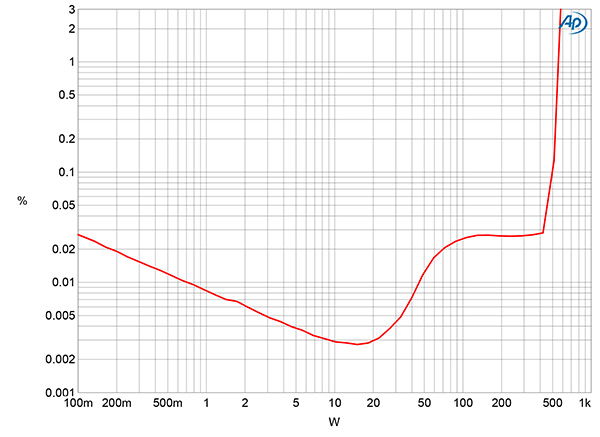
In bridged-mono mode, the clipping powers were 550W into 8 ohms (27.4dBW, fig.6) and 810W into 4 ohms (26.1dBW) compared with the specified 450W into 8 ohms (26.5dBW) and 600W into 4 ohms (24.8dBW). In class-A, the shape of the trace in mono mode was similar to that in stereo mode (fig.5) other than the higher clipping power.


In both output classes, the THD+N percentage at 20V, which is equivalent to 50W into 8 ohms, 100W into 4 ohms, and 200W into 2 ohms, was higher in the right channel (fig.7, red, magenta, and gray traces) than it was in the left (blue, cyan, green). More significantly, the THD+N percentage in both channels was higher into 4 ohms and 2 ohms. It also increased in the top audio octaves, which implies that the amplifier has limited open-loop bandwidth. At the same output voltage, the THD+N was higher in bridged-mono mode (fig.8).
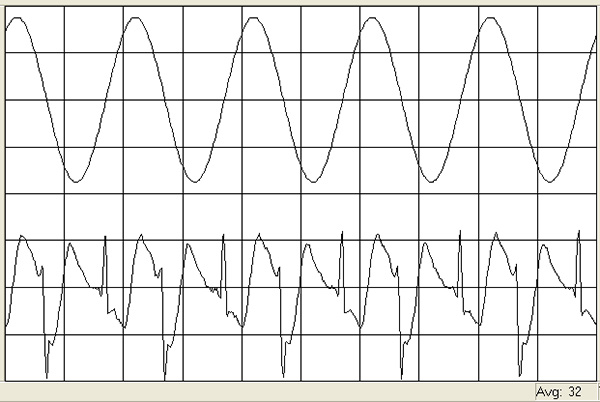
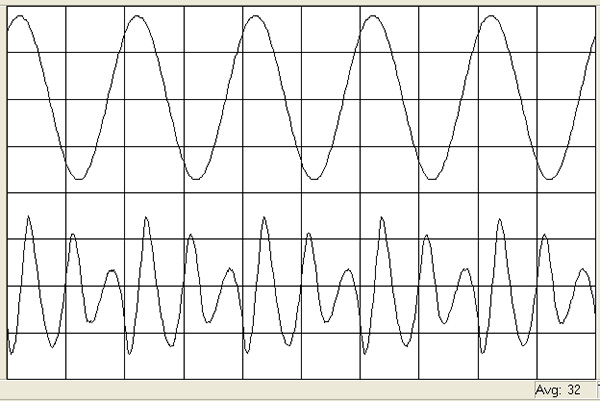
The distortion waveform in class-AB had some crossover artifacts (fig.9), but these were absent in class-A, where the third harmonic was dominant (fig.10).


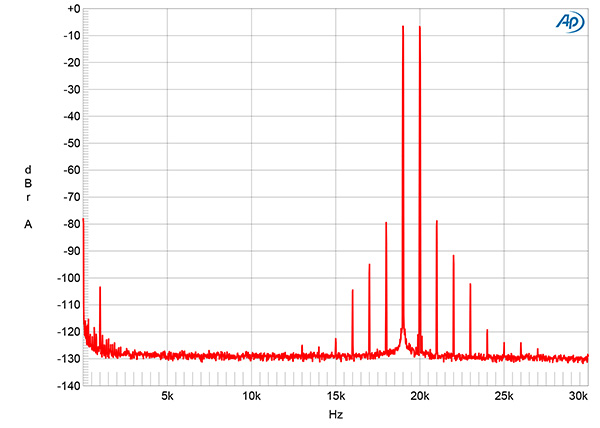
In class-AB, the third harmonic was higher in the right channel (fig.11, red trace) and the second harmonic was present at a lower level. The third harmonic was still the highest in level in class-A (fig.12), but it is at the same level in both channels, at –80dB (0.01%). Higher harmonics were also much lower in class-A. Intermodulation distortion with an equal mix of 19- and 20kHz tones was low in level in both stereo and mono modes and in class-AB and class-A (fig.13).
The Plinius A-150's measurements indicate that class-A operation is optimal, where it offers high power with low distortion, especially in bridged-mono mode. It will perform best in both stereo and mono modes with loudspeakers whose impedance remains at or above 4 ohms.—John Atkinson

There are only 8 ohms in both modes and bridged. But have you measured it on 4 ohms too?

Shame that it's massive near 40kg weight doesn't reflect in it's current ability into low impedances like normal true complimentary NPN/PNP push pull bi-polar amps can. EG:JC1's, Agostino, Krell ect etc
A little lame in it's current ability into the low impedances of the Alexia, hence the "bass was a mite wooly" sound description by Jason into the Alexia's, even though it has nice low output impedance .012ohm?
Cheers George

Seems like a lot of juice and hassle for an amp that is just very good